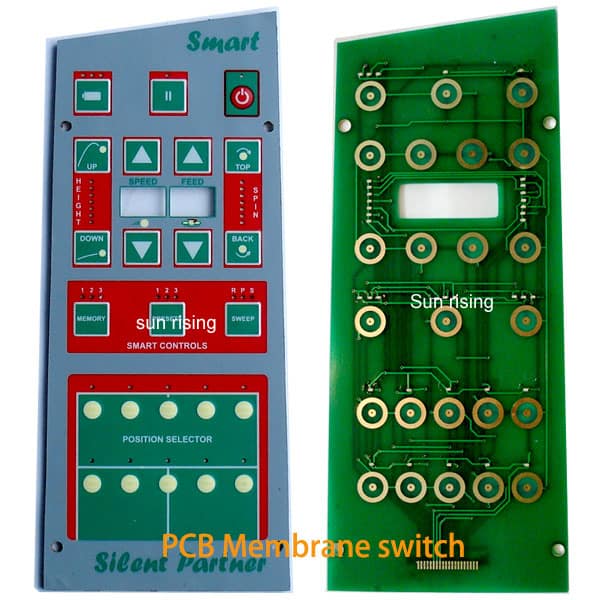Membrane Switches vs. Traditional Switches: What You Need to Consider
Membrane Switches vs. Traditional Switches: What You Need to Consider
Blog Article
Why Membrane Layer Switches Over Are Necessary for Resilient Control Equipment
Membrane switches play an essential role in ensuring the sturdiness and integrity of control systems across numerous industries. As we explore the multifaceted advantages of membrane layer switches, it ends up being evident that their relevance goes beyond simple capability, affecting user experience and functional performance.
Overview of Membrane Buttons
Membrane layer switches are flexible and trusted components frequently made use of in numerous electronic control systems. These buttons consist of several layers, including a visuals overlay, a spacer layer, and a printed circuit layer. The visuals overlay provides both practical and aesthetic style, while the spacer layer makes certain that the switches are turned on just when pushed. The printed circuit layer includes conductive traces that finish an electrical circuit when the membrane layer is pressed, enabling the device to react to user inputs.
Membrane layer buttons are usually preferred in applications calling for a small and lightweight design, making them ideal for portable tools, clinical tools, and industrial machinery. They can be customized to meet particular user needs and can integrate different features such as backlighting, tactile responses, and multiple colors. Membrane switches are resistant to dirt, wetness, and pollutants, making them suitable for settings where toughness is necessary.
Advantages of Durability
In several applications, the sturdiness of membrane layer switches over offers significant benefits that enhance their overall performance and reliability. These buttons are developed to withstand extreme environments, making them excellent for usage sought after problems such as high humidity, severe temperatures, and exposure to chemicals. Their robust building and construction assists to avoid damage from physical influence, making sure lasting capability and reducing the need for frequent substitutes.
Furthermore, membrane layer switches are resistant to deterioration, which is critical in applications where frequent interaction takes place. This resilience converts to lower maintenance costs, as companies gain from decreased downtime and less solution disruptions. The encapsulated design of membrane changes shields internal parts from dust and dampness access, more contributing to their life expectancy (membrane switch).
Another advantage is their capability to keep regular efficiency gradually. With a high tolerance for mechanical tension, these switches protect their tactile comments and electric integrity, making sure individual satisfaction. Ultimately, the resilience of membrane changes not only improves operational efficiency however additionally fosters confidence in their reliability, making them a preferred selection for control systems throughout numerous industries.
Applications in Different Industries
Resilient control systems employing membrane buttons locate comprehensive applications across a range of sectors, each profiting from the special qualities these switches supply. In the clinical industry, membrane buttons are essential for devices such as individual monitors and analysis devices, where dependability and ease of cleansing are critical. Their resistance to moisture and impurities ensures they maintain capability in sterilized settings.
The automobile industry leverages membrane layer switches for control panel controls and infotainment systems, where they give smooth, low-profile user interfaces that enhance customer experience. These switches are likewise developed to withstand rough conditions, consisting useful content of exposure to extreme temperatures and resonances.
In industrial setups, membrane buttons are frequently utilized in machinery control board, offering responsive feedback and longevity essential for high-usage applications. Their capability to stand up to chemicals makes them appropriate for making environments where spills and impurities are constant.

Consumer electronic devices, such as cooking area appliances and push-button controls, also utilize membrane buttons for their convenience and cost-effectiveness. In general, the versatility and durable nature of membrane layer switches over make them essential across numerous fields, making certain effective procedure and long life in control systems.
Design and Aesthetic Appeal
While performance is extremely important, the style and visual allure of control systems equipped with membrane switches play a critical function in individual interaction and total experience (membrane switch). The aesthetic layout of these switches can dramatically affect customer assumption and communication. A properly designed membrane button boosts the good looks of the tool, making it extra appealing to customers and fostering a connection between the user and the product
Membrane switches offer a lot of versatility in style, allowing manufacturers to tailor graphics, shades, and appearances to line up with brand identity and item visual appeals. Using lively colors and distinctive patterns can attract focus, while responsive comments can enhance the user's communication with the gadget. Furthermore, the capability to incorporate LED signs and backlighting right into the membrane switch style supplies both functional and visual advantages, improving visibility and use in various settings.

Enhancing Individual Experience

Moreover, membrane layer switches can be personalized to integrate visual user interfaces, boosting use by presenting details in a clear and intuitive manner (membrane switch). This personalization can include icons, labels, and color coding that guide customers via facility functionalities easily. Additionally, their flexibility enables for combination in different atmospheres, making sure constant performance whether in industrial machinery or customer electronics
The resilience of membrane switches also Discover More plays a critical role in customer experience. By enduring rough problems and prolonged use, these switches lower the chance of system failings, thus promoting reliability and user self-confidence. Inevitably, the calculated use membrane changes not just elevates functionality yet likewise considerably enriches customer communication with control systems, making them an important element in modern layout.
Final Thought

Report this page